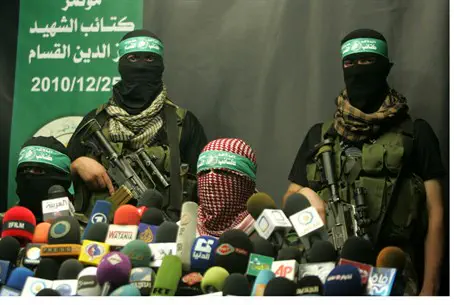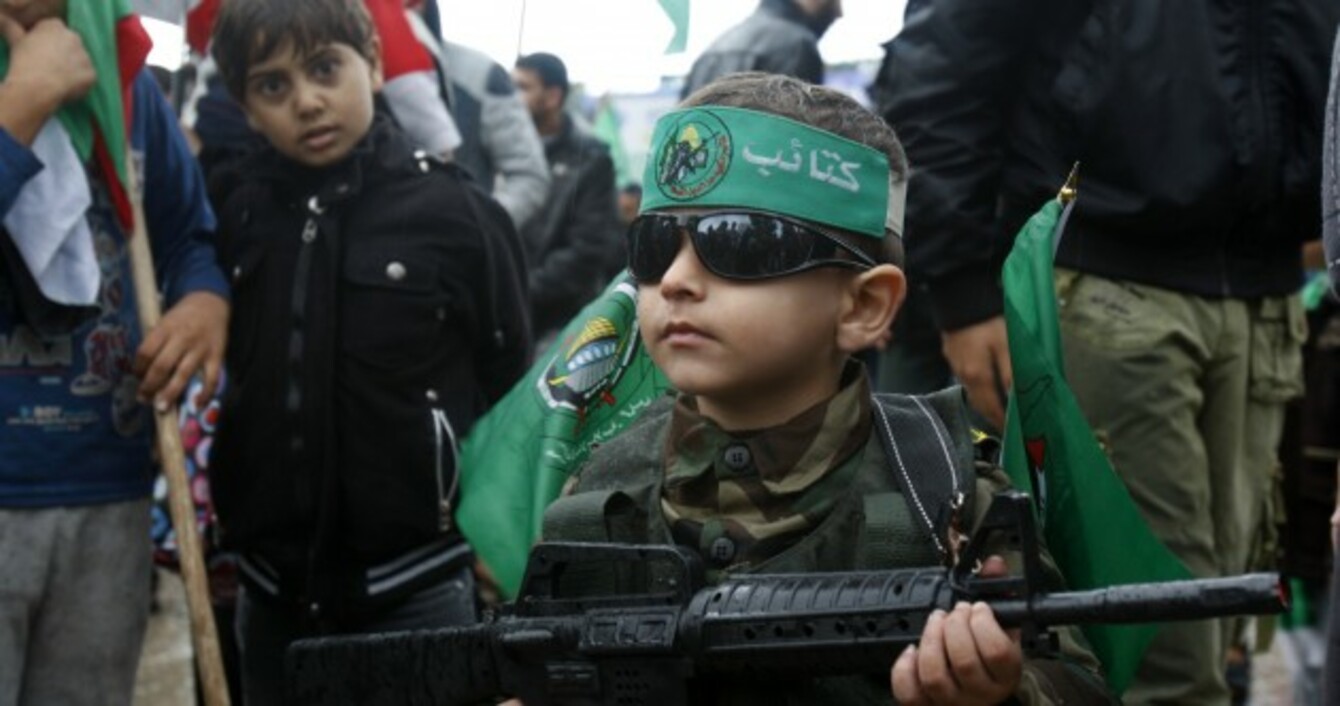Hamas takes the antisemitism out of its charter

The armed wing of Hamas at a rally commemorating the 27th anniversary of the Hamas group, Gaza City, Gaza, 2014. Photo by AP
The Enemy Just Blinked: Why Hamas’s New Charter Is a Big Deal
The revisions to Hamas’ infamously antisemitic and pro-violence founding document is unprecedented evidence that even an extremist organization is capable of change.
By Björn Brenner, Haaretz premium
March 22, 2017
Thirty years after it was founded, Hamas is replacing its antisemitic and violent charter with a comprehensively revised document modifying several of its extreme and rejectionist positions. While several of these strategic changes are not completely new – they have at times been talked about by Hamas leaders, but later retracted or contradicted – expressly including them in its charter constitutes something quite unprecedented.
No matter what immediate effect these changes will have on Hamas’s behaviour, from a broader strategic perspective, this is a big deal. The main reason for this is because the internal process required within Hamas to get all its different parts to unite and ratify these changes is simply enormous. The resolve and energy necessary to carry through this type of internal process is in itself proof of the importance attached to this change within Hamas.
Moreover, the actual group of individuals who have initiated and pushed through this enterprise have put their future in the organisation at stake, as well as their lives if it were to fail. To stand up in one of Hamas’s shura councils, surrounded by extremists, and argue that the time has come to depart from the organisation’s original plan as set out by its founding fathers cannot have been easy. To most members, this idea at first glance would have appeared tantamount to surrender – and to the more conservative ones, to heresy.

Girls look on when boys on a float play at being Hamas soldiers. Rally by Hamas supporters in the West Bank city of Ramallah, Aug. 30, 2014. Photo by Abbas Momani/AFP/Getty Images
Moving Hamas from its position of utter rejection of Israel to achieving a consensus about the necessity for change, this group of individuals have engaged in several years of contentious internal debate. The process has also included extensive secret communication between Hamas’s different organisational units in all of its four physically separated parts: Gaza, the West Bank, the prisons and the diaspora. At numerous times, Hamas’s leadership has circulated various drafts of the document for comments, amendments and reservations from all of the different parts and units.
In addition to the difficult nature of the process in itself, the actual content of these changes also underlines the magnitude of all this. The new charter will include redresses of several of the group’s most controversial standpoints, including:
[see NOTE at end for list of main changes]
A Palestinian state – Hamas will now agree on a Palestinian state based on pre-1967 borders. While not explicitly saying what will be on the other side of these borders, this acknowledges the existence of a foreign entity on the other side. Hamas will also say that it backs any peace agreement that can be reached between Israel and the Palestinian leadership, if it can be approved in a popular referendum.
Armed struggle – As opposed to its former calls for the indiscriminate use of violence, Hamas will now state that, while it still considers the use of force to be its legitimate right, its focus will instead be on non-violent and popular resistance activities.

The soldiers of Hamas have immense attraction for small boys.
Hamas won’t be relinquishing its arms. It still calls for the destruction of Israel beyond the pre-1967 lines.
.
.
Non-Muslims – Hamas’s new charter will relate to other religions, Judaism and Christianity in particular, in more conciliatory language. As opposed to the explicitly anti-Semitic references in the former document, Hamas will now say that religious minorities constitute an integral component of Palestinian society. Regarding Jews, the document will specify that Hamas’s struggle concerns only those individuals who operate in and have settled beyond pre-1967 lines.
Relations with other Islamic organisations – Hamas will state that it does not have any organisational ties to other Islamic organisations. Due to its former close ties with the Muslim Brotherhood, this statement marks a new chapter in the history of Hamas. Having recently been accused of conspiring with the Brotherhood against the Egyptian regime, as well as cooperating with global Salafi-Jihadi groups in Sinai, this is an attempt on the part of Hamas to deal with this. By doing so, however, Hamas will be regarded as a traitor by other extreme Islamist groups and risk a new wave of defections from its military ranks.

Members of Al-Qassam brigades, the armed wing of the Hamas movement, take part in a news conference in Gaza City, December 2010. The face-covering may be to protect themselves from IDF assassination – or to instil fear in the Palestinian population. Photo by Mohammed Othman/Flash90
In spite of all this, it is important to keep in mind that so far we are only talking about changes that have been made on paper. In addition, the reason behind these changes is not due to any profound longing for peace and democracy on the part of Hamas. Rather, it is all about real politics and flexibly adapting to the situation at hand. What we are seeing is nothing but a highly skilled political actor struggling to keep pace with changing political realities.
At the end of the day, Hamas has not yet relinquished its arms and is still calling for the destruction of Israel beyond the pre-1967 lines. But, importantly – no matter what Hamas’s potentially ignoble intentions behind changing its charter may be – these changes are now a fait accompli, inked into its key ideological document and left there for the next generation of Hamsawis to deal with.
A boy sits on his father’s shoulders with a toy gun during a celebration by the Muslim Brotherhood to declare the victory of Gaza and Hamas against Israel in Amman, Jordan, Friday, Aug. 29, 2014. Photo by Mohammad Hannon/ AP
This shows that Hamas is indeed capable of change – and has realised that there will never be a Palestinian state spanning all the way “between the river and the sea”. While this might not lead to any palpable results for Israelis immediately, eventually it will. For now, let us nevertheless recognise what has just happened. For the first time ever, the enemy just blinked.
Björn Brenner is a lecturer at the Swedish Defence University in Stockholm and a visiting fellow at Institut français du Proche-Orient in Amman, Jordan. He has conducted extensive field research in Syria, Jordan, the West Bank and Gaza. His latest book, “Gaza Under Hamas: From Islamic Democracy to Islamist Governance,” was recently published by I.B.Tauris. Follow him on Twitter: @bjornbrenner
New Hamas Charter Would Name ‘Occupiers,’ Not ‘Jews,’ as the Enemy
By Ian Fisher and Majd Al Waheidi, NY Times
March 09, 2017
CAIRO — Hamas, the Palestinian Islamist group that has governed the Gaza Strip for a decade, is drafting a new platform to present a more pragmatic and cooperative face to the world, Hamas officials confirmed on Thursday.
The document would represent a departure from the group’s contentious 1988 charter, in which it promised to “obliterate” Israel and characterized its struggle as specifically against Jews. The new document defines Hamas’s enemies as “occupiers.”
“It means that we don’t fight Jews because they are Jews,” said Taher el-Nounou, a Hamas spokesman in Gaza. “Our struggle is only against those who occupied our lands.”
The new document would accept borders of the territory captured by Israel in the 1967 war as the basis for a Palestinian state. It would not recognize Israel, however, nor would it give up future claims to all of what Hamas considers Palestinian lands.
Mr. Nounou said the document, the result of four years of work, is not yet final and has not yet been approved by Hamas’s governing bodies. Nor are its contents wholly new, even though they seem now to carry both practical and symbolic weight, particularly in Hamas’s relations with Egypt.
Egypt controls the southern border of Gaza, limiting the movement of people and goods in and out of the increasingly impoverished territory.
Israel controls access from all other sides, including the Mediterranean, in what critics call a siege against the enclave of more than two million people.
To improve Hamas’s ties with Egypt, the document would declare that the group is not a part of the Muslim Brotherhood, which is under increasing government pressure in Egypt. Hamas’s 1988 charter specified that the group was a part of the Muslim Brotherhood.
Hamas officials and other analysts said the document seemed intended to alleviate the group’s international isolation.
Hamas is considered a terrorist group by the United States, by many other nations and by the European Union, and it has found itself marginalized while its main Palestinian rival, the Fatah faction that rules the West Bank, engages in international diplomacy to advance the Palestinian cause.
The new document, however moderated, is not likely to change that situation by itself.
But Ahmad Yousif, an expert on Islamic movements who once served as an adviser to the Hamas leader Ismail Haniya, said the new platform might help soften outside perceptions of the group.
“The covenant was criticized because its language was against Jews and international law,” he said, referring to the 1988 charter. “Now we have a document that says Jews are not our enemy.”
“The enemy is clear: the Zionist occupation,” he said.
Kobi Michael of the Institute for National Security Studies at Tel Aviv University said he was sceptical of the new document. Mr. Michael, who formerly led the Palestinian desk at the Israeli Ministry for Strategic Affairs, said there was no assurance that Hamas would adopt the new platform.
Even if it did, he said, the document would not change Hamas’s policy of violent resistance against Israel, nor weaken the grip of its new hard-line leader in Gaza, Yehya Sinwar. “They are trying to use the sort of language that will be more accepted by the international community,” Mr. Michael said of Hamas. “They will not change their methods — the use of terror and the use of violence against Israeli citizens.”
Ian Fisher reported from Cairo, and Majd Al Waheidi from Gaza.
NOTE
Charter changes
Hamas will now agree on a Palestinian state based on pre-1967 borders.
Its focus will be on non-violent and popular resistance activities though it hasn’t renounced armed struggle.
It agrees a Palestinian state will be based on pre-1967 borders, no longer from the Jordan to the sea.
Hamas will say that religious minorities constitute an integral component of Palestinian life. Its struggle will only be with settlers.
The document will declare Hamas is NOT part of the Muslim Brotherhood.

